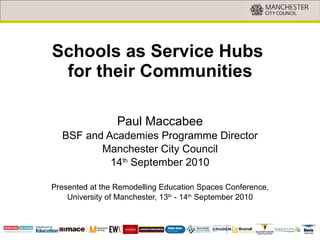Paul Maccabee, Manchester City Council
- 1. Schools as Service Hubs for their Communities Paul Maccabee BSF and Academies Programme Director Manchester City Council 14 th September 2010 Presented at the Remodelling Education Spaces Conference, University of Manchester, 13 th - 14 th September 2010
- 2. MCC Schools Building Programme BSF / Academies - 33 Schools ?500m programme, Design and Build (nil PFI) Whole Estate: 55% GIFA New Build, 45% Retained / Re-Modelled Primary Capital Programme "Pathfinder Authority" ?27 million, 2008-2011 Key driver to ManchesterĪ»s Regeneration Strategy
- 3. MCC Approach to Community Use All schools are service hubs for their local communities Commitment established at planning stage (almost as a condition of the capital investment) via ĪŁ Community Hub Statements ©C agreements between the schools and the local authority establishing priorities and opportunities for community use Not limited by PFI agreements Limited by ongoing school commitment ©C but reinforced by inspection / improvement frameworks, e.g. OFSTED, SIPs
- 4. Community Hub Statements Local needs / opportunities established Steering group consisting of: School Extended Schools Team, and the Local Regeneration Team (whose job it is to map service provision at neighbourhood level)
- 5. GIS ©C Community Services
- 6. Co-Location of Public Services: East Manchester Academy & District Library
- 7. Primary schools co-located with SureStart ChildrenĪ»s Centres
- 8. Key Design Issues Access / Entrances / Zoning Space Planning: Core school space / community space Specialist Areas: Science D + T Art PE Music Inclusion YEAR 11 YEAR 10 YEAR 8 YEAR 9 L L A 10 L L A 9 L L A 8 L L A 7 L L A 4 L L A 5 L L A 6 L L A 3 YEAR 7 Large Learning Area 1 Large Learning Area 2 YEAR 7 Unobtrusive Security Line SPATIAL RELATIONSHIPS DIAGRAM ENTRANCE Warm, Welcoming, Light + Airy, Display, Information Students Staff Visitors Visiting Students Agency Rooms Interview Rooms Community Learning Sixth Form + Vocational Areas Visitor + Staff Toilets Sickbay Main Office Reception Cafe PE Music Core School Zone Community Community / School Interface Specialist Areas: Science D + T Art PE Music Inclusion YEAR 11 YEAR 10 YEAR 8 YEAR 9 L L A 10 L L A 9 L L A 8 L L A 7 L L A 4 L L A 5 L L A 6 L L A 3 YEAR 7 Large Learning Area 1 Large Learning Area 2 YEAR 7 Unobtrusive Security Line SPATIAL RELATIONSHIPS DIAGRAM ENTRANCE Warm, Welcoming, Light + Airy, Display, Information Students Staff Visitors Visiting Students Multi-Agency Rooms Interview Rooms Community Learning Sixth Form + Vocational Areas Visitor + Staff Toilets Sickbay Main Office Reception Cafe PE Music Core School Zone Community Community / School Interface
- 11. Entrance Detailing ©C Brookburn Primary School Before After
- 12. Facilities Management Issues Best results achieved where schools have dedicated personnel, e.g. Gorton Education Village ©C 80% increase in community use - the Estates Director more than pays for herself from income generated from e.g. weddings The school occupies a different place in its community
- 13. ?












